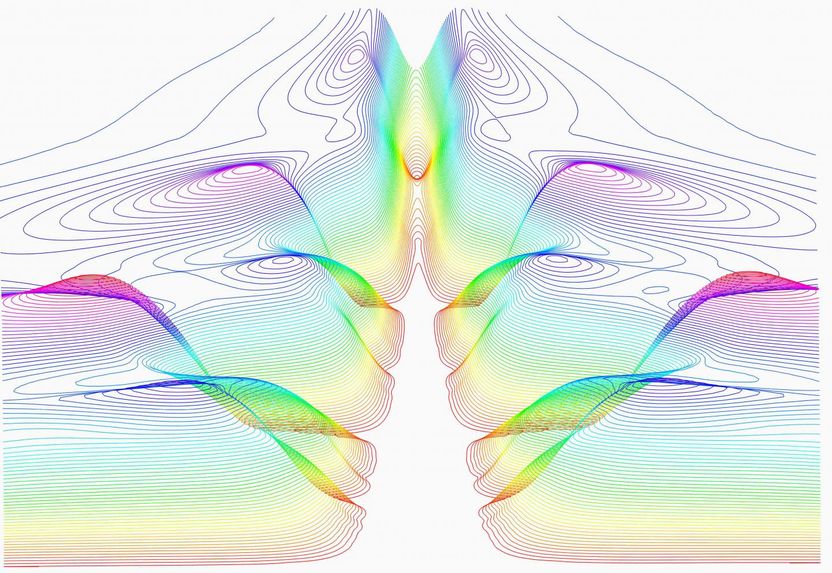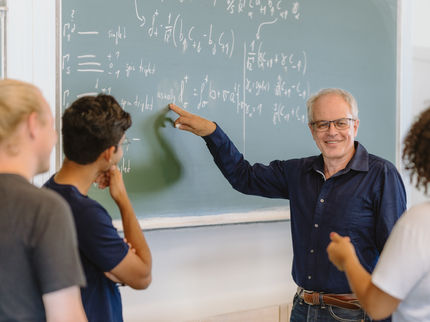Team announces breakthrough observation of Mott transition in a superconductor
An international team of researchers, including the MESA+ Institute for Nanotechnology at the University of Twente in the Netherlands and the U.S. Department of Energy's Argonne National Laboratory, announced the observation of a dynamic Mott transition in a superconductor.

Scientists announced the first observation of a dynamic vortex Mott transition, which experimentally connects the worlds of quantum mechanics and classical physics and could shed light on the poorly understood world of non-equilibrium physics.
Image courtesy Valerii Vinokur, Argonne National Laboratory/Science
The discovery experimentally connects the worlds of classical and quantum mechanics and illuminates the mysterious nature of the Mott transition. It also could shed light on non-equilibrium physics, which is poorly understood but governs most of what occurs in our world. The finding may also represent a step towards more efficient electronics based on the Mott transition.
The Mott transition occurs in certain materials that according to textbook quantum mechanics should be metals, but in reality turn insulators. A complex phenomenon controlled by the interactions of many quantum particles, the Mott transition remains mysterious - even whether or not it's a classical or quantum phenomenon is not quite clear. Moreover, scientists have never directly observed a dynamic Mott transition, in which a phase transition from an insulating to a metallic state is induced by driving an electrical current through the system; the disorder inherent in real systems disguises Mott properties.
At the University of Twente, researchers built a system containing 90,000 superconducting niobium nano-sized islands on top of a gold film. In this configuration, the vortices find it energetically easiest to settle into energy dimples in an arrangement like an egg crate--and make the material act as a Mott insulator, since the vortices won't move if the applied electric current is small.
When they applied a large enough electric current, however, the scientists saw a dynamic Mott transition as the system flipped to become a conducting metal; the properties of the material had changed as the current pushed it out of equilibrium.
The vortex system behaved exactly like an electronic Mott transition driven by temperature, said Valerii Vinokur, an Argonne Distinguished Fellow. He and Tatyana Baturina, then at Argonne, analyzed the data and recognized the Mott behavior.
"This experimentally materializes the correspondence between quantum and classical physics," Vinokur said.
"We can controllably induce a phase transition between a state of locked vortices to itinerant vortices by applying an electric current to the system," said Hans Hilgenkamp, head of the University of Twente research group. "Studying these phase transitions in our artificial systems is interesting in its own right, but may also provide further insight in the electronic transitions in real materials."
The system could further provide scientists with insight into two categories of physics that have been hard to understand: many-body systems and out-of-equilibrium systems.
"Furthermore, this system will be key to building a general understanding of out-of-equilibrium physics, which would be a major breakthrough in physics," Vinokur said.
As we seek to make electronics faster and smaller, Mott systems also offer a possible alternative to the silicon transistor. Since they can be flipped between conducting and insulating with small changes in voltage, they may be able to encode 1s and 0s at smaller scales and higher accuracy than silicon transistors.
'Initially, we were studying the structures for completely different reasons, namely to investigate the effects of inhomogeneities on superconductivity," Hilgenkamp said. "After discussing with Valerii Vinokur at Argonne, we looked more specifically into our data and were quite amazed to see that it revealed so nicely the details of the transition between the state of locked and moving vortices. There are many ideas for follow up studies, and we look forward to our continued collaboration."






























































